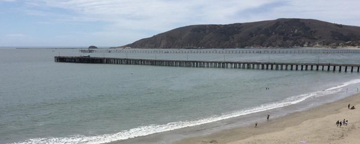 | |
| SLO town — San Luis Obispo — from an angle we never saw it as college kids. (Forget what I said about cameras before: I'm a mad fool with a smart phone, taking more pictures than anyone would judge dignified. |
Our sole mission: To see what's around the corner.
The only sure thing was where we'd stay for the night, and we weren't even sure about that.
The little Forest Service campground above Morro Bay on the Central Coast put us in a site next to a trailer that, despite being empty, thrummed and vibrated with a generator at top speed, so Nancy found a better spot.
Long ago a hill sloped all the way to the edge of a creek, and the Forest Service cut a road into that slope along the creek, and banked a steep berm with rocks and put a campsite atop the berm, above the road and out of sight of any passing parade: My fantasy campsite.
 |
| Filleting the catch of the day: A spectator sport in Morro Bay. |
Another time (with kids in tow, I mean) we would have spent most of our time at the campsite, the kids making a fantasy land of the high stone wall, Mom and I blocking off the ledge with lawn chairs and stacks of firewood and constant admonition not to go anywhere it.
We would have gone into town only as long as the kids' endurance and our patience held out.
This time, just Nancy and me, we only saw our funky campsite late at night and early in the morning.
 |
| Must … have … coffee. |
The three PG&E smokestacks from the out-of-commission power plant still reach to the sky, a counterpoint to Morro Rock. People hated those stacks when they went in, I understand; now they're not sure they want to get rid of them. They show up in paintings, next to the rock, in the town's art galleries.
We rented a canoe and paddled along the town back to the estuary, where long ago we remembered the labyrinth of gullies winding around islands of pickleweed actually clattered and clicked with dozens of crabs. We saw a few crabs this time but they weren't in a noisy mood.
 |
| They like to decorate electrical boxes in San Luis Obispo. |
After paddling a couple of miles and turning in our rental, I asked the rental attendant whether anyone swims in Morro Bay.
"Sure, Chief," the kid said, "You can swim anywhere you want, just jump right in."
It wasn't what I meant.
"Wouldn't the harbor master want swimmers out of the ship channel?"
"This is the United States of America, Boss," the kid said. "You can swim anywhere you want."
 |
| A sculpture, by Elizabeth MacQueen, honoring Chinese railroad builders in San Luis Obispo. |
Day one.
Day two, we parked our car near the railroad tracks in the south part of San Luis Obispo, our college town, and walked into the center of town. Some of San Luis Obispo reminded us of our days of yore. A lot of it was a complete cipher.
Unless you come from some Los Angeles suburb: Then the city looks familiar. San Luis Obispo, still lovely, used to embrace a lot of funk, with homegrown shops that sold specialty food at prices college students could occasionally afford.
Some of those stores still exist. More stores look like Los Angeles got its hooks in the town, with high-end shopping for students' parents who find the town too serene, the cool trail along the lush creek beneath Mission San Luis Obispo too lovely.
Full of tri-tip lunch, we walked and walked and walked — then decided to take in a movie. It'd been a year, after all — since our last vacation.
 |
| Everything is beautiful, in its own way. |
Later, we disappeared into a bar — something we never did in college — to watch the last innings of a Giant blowout over the Cincinnati Reds. I ordered pizza on my phone — this is akin to man making fire — and we gave half to some men living under bushes in a business park, and ate the rest on the way back to camp.
Day 3, we drank good coffee on the beach at Cayucos, the little town north of Morro Bay, then drove to Avila Beach where I had hoped to swim with a group I joined three or four years ago. There they were, waiting below the boardwalk.
 |
| Avila Beach — I wouldn't have been seen without a T shirt here as a teenager, yet here I am doing a deck change on the beach, swimming barechested with the beasties of the deep. |
I wore sea salt home like a cape. We said our goodbyes to my sister who stopped by, and slogged our way home.
Let's go 30 more.


No comments:
Post a Comment